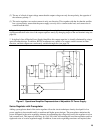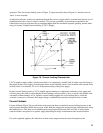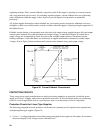
31
Figure 13. Basic Switching Regulator Configurations
Configuration B is a useful alternative to push-pull operation for lower power requirements It is called a
forward, or feed-through, converter because energy is transferred to the power transformer secondary
immediately following turn-on of the switch. Although the ripple frequency is inherently lower, output ripple
amplitude can be effectively controlled by the choke in the output filter. Two-transistor forward converters also
exist wherein both transistors are switched simultaneously. They provide the same output power as the single
transistor versions, but the transistors need handle only half the peak voltage.
Configuration C is known as a flyback, or ringing choke, converter because energy is transferred from primary
to secondary when the switches are off (during flyback). In the example, two transistors are used and both are
switched simultaneously. While the switches are on, the output rectifier is reverse biased and current in the
primary inductance rises in a linear manner. When the switches are turned off, the collapsing magnetic field
reverses the voltage across the primary, and the previously stored energy is transferred to the output filter and
load. The two diodes in the primary protect the transistors from inductive surges that occur at turn-off.
Flyback techniques have long been used as a means of generating high voltages (e. g., the high voltage power
supply in television receivers) and, as you might expect, this configuration is capable of providing higher output
voltages than the other two methods. Also, the flyback regulator provides a greater variation of output voltage
with respect to changes in duty cycle. Hence, the flyback configuration is the most obvious choice for high, and
variable, output voltages while the push-pull and forward configurations are more suitable for providing low,
and fixed, output voltages.
SCR Regulation
SCR regulation techniques permit the design of low cost, compact power supplies with efficiencies of
approximately 70%. Their main disadvantages are a higher ripple and noise, a less precise regulation, and a
slower transient recovery time relative to the other three regulation methods. However, these supplies are
widely used in high power applications where a lower degree of performance can be tolerated.


















